Understanding Asset Revaluations and Impairment Losses Implications
VerifiedAdded on 2022/10/02
|5
|792
|267
Report
AI Summary
This report examines the implications of asset revaluations and impairment losses on a company's financial performance, focusing on profits and equity value. It analyzes the impact of these accounting practices, particularly concerning intangible assets and adherence to accounting standards like AASB 136. The report references the Australian Financial Review articles and uses the AASB Framework to support its arguments. It highlights the consequences of asset impairments, such as those experienced by Myer, and the role of regulatory bodies like ASIC in scrutinizing asset valuations. The discussion is tailored for a general audience, avoiding technical jargon while providing a clear understanding of the subject.
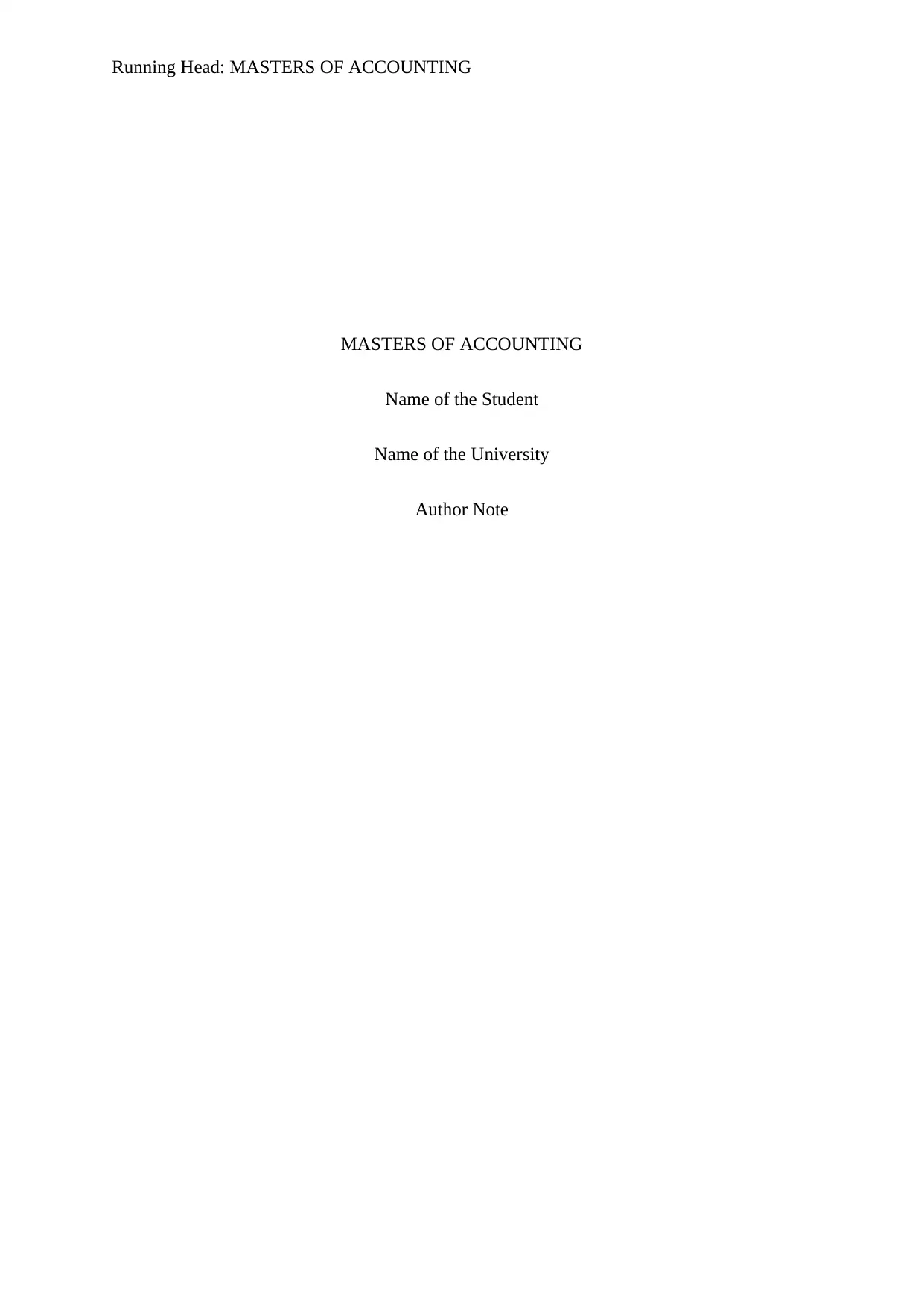
Running Head: MASTERS OF ACCOUNTING
MASTERS OF ACCOUNTING
Name of the Student
Name of the University
Author Note
MASTERS OF ACCOUNTING
Name of the Student
Name of the University
Author Note
Paraphrase This Document
Need a fresh take? Get an instant paraphrase of this document with our AI Paraphraser
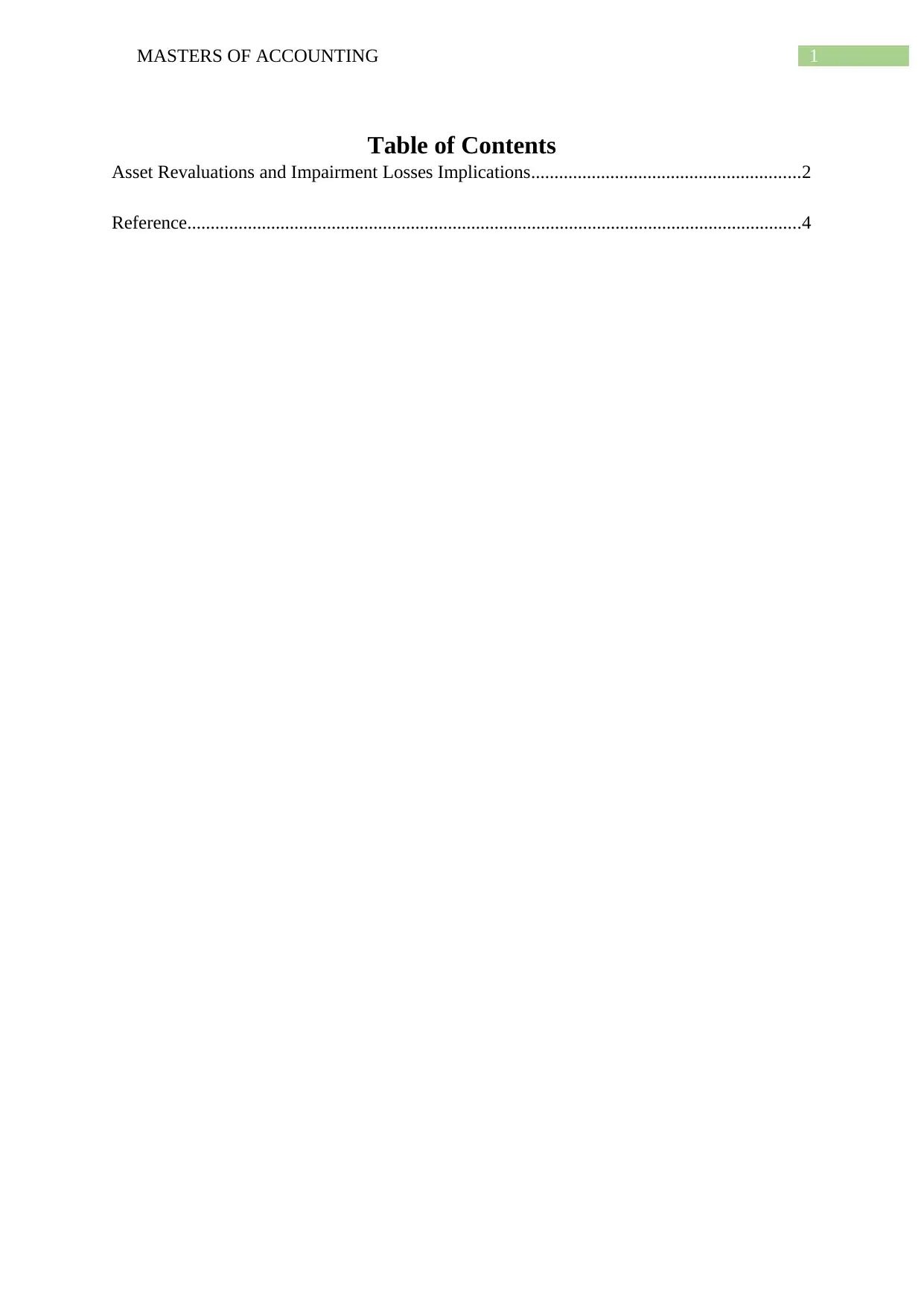
1MASTERS OF ACCOUNTING
Table of Contents
Asset Revaluations and Impairment Losses Implications..........................................................2
Reference....................................................................................................................................4
Table of Contents
Asset Revaluations and Impairment Losses Implications..........................................................2
Reference....................................................................................................................................4
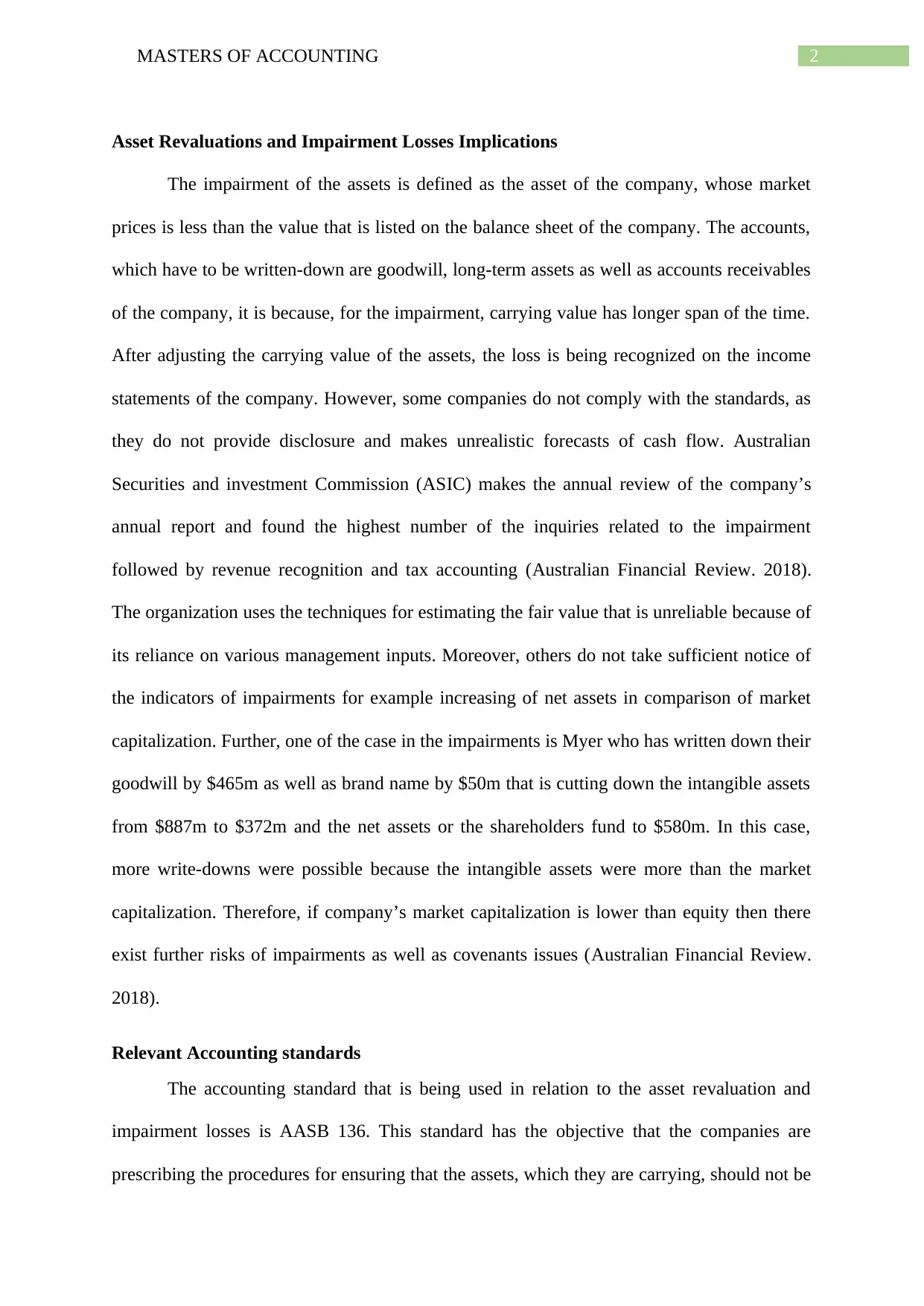
2MASTERS OF ACCOUNTING
Asset Revaluations and Impairment Losses Implications
The impairment of the assets is defined as the asset of the company, whose market
prices is less than the value that is listed on the balance sheet of the company. The accounts,
which have to be written-down are goodwill, long-term assets as well as accounts receivables
of the company, it is because, for the impairment, carrying value has longer span of the time.
After adjusting the carrying value of the assets, the loss is being recognized on the income
statements of the company. However, some companies do not comply with the standards, as
they do not provide disclosure and makes unrealistic forecasts of cash flow. Australian
Securities and investment Commission (ASIC) makes the annual review of the company’s
annual report and found the highest number of the inquiries related to the impairment
followed by revenue recognition and tax accounting (Australian Financial Review. 2018).
The organization uses the techniques for estimating the fair value that is unreliable because of
its reliance on various management inputs. Moreover, others do not take sufficient notice of
the indicators of impairments for example increasing of net assets in comparison of market
capitalization. Further, one of the case in the impairments is Myer who has written down their
goodwill by $465m as well as brand name by $50m that is cutting down the intangible assets
from $887m to $372m and the net assets or the shareholders fund to $580m. In this case,
more write-downs were possible because the intangible assets were more than the market
capitalization. Therefore, if company’s market capitalization is lower than equity then there
exist further risks of impairments as well as covenants issues (Australian Financial Review.
2018).
Relevant Accounting standards
The accounting standard that is being used in relation to the asset revaluation and
impairment losses is AASB 136. This standard has the objective that the companies are
prescribing the procedures for ensuring that the assets, which they are carrying, should not be
Asset Revaluations and Impairment Losses Implications
The impairment of the assets is defined as the asset of the company, whose market
prices is less than the value that is listed on the balance sheet of the company. The accounts,
which have to be written-down are goodwill, long-term assets as well as accounts receivables
of the company, it is because, for the impairment, carrying value has longer span of the time.
After adjusting the carrying value of the assets, the loss is being recognized on the income
statements of the company. However, some companies do not comply with the standards, as
they do not provide disclosure and makes unrealistic forecasts of cash flow. Australian
Securities and investment Commission (ASIC) makes the annual review of the company’s
annual report and found the highest number of the inquiries related to the impairment
followed by revenue recognition and tax accounting (Australian Financial Review. 2018).
The organization uses the techniques for estimating the fair value that is unreliable because of
its reliance on various management inputs. Moreover, others do not take sufficient notice of
the indicators of impairments for example increasing of net assets in comparison of market
capitalization. Further, one of the case in the impairments is Myer who has written down their
goodwill by $465m as well as brand name by $50m that is cutting down the intangible assets
from $887m to $372m and the net assets or the shareholders fund to $580m. In this case,
more write-downs were possible because the intangible assets were more than the market
capitalization. Therefore, if company’s market capitalization is lower than equity then there
exist further risks of impairments as well as covenants issues (Australian Financial Review.
2018).
Relevant Accounting standards
The accounting standard that is being used in relation to the asset revaluation and
impairment losses is AASB 136. This standard has the objective that the companies are
prescribing the procedures for ensuring that the assets, which they are carrying, should not be
⊘ This is a preview!⊘
Do you want full access?
Subscribe today to unlock all pages.

Trusted by 1+ million students worldwide
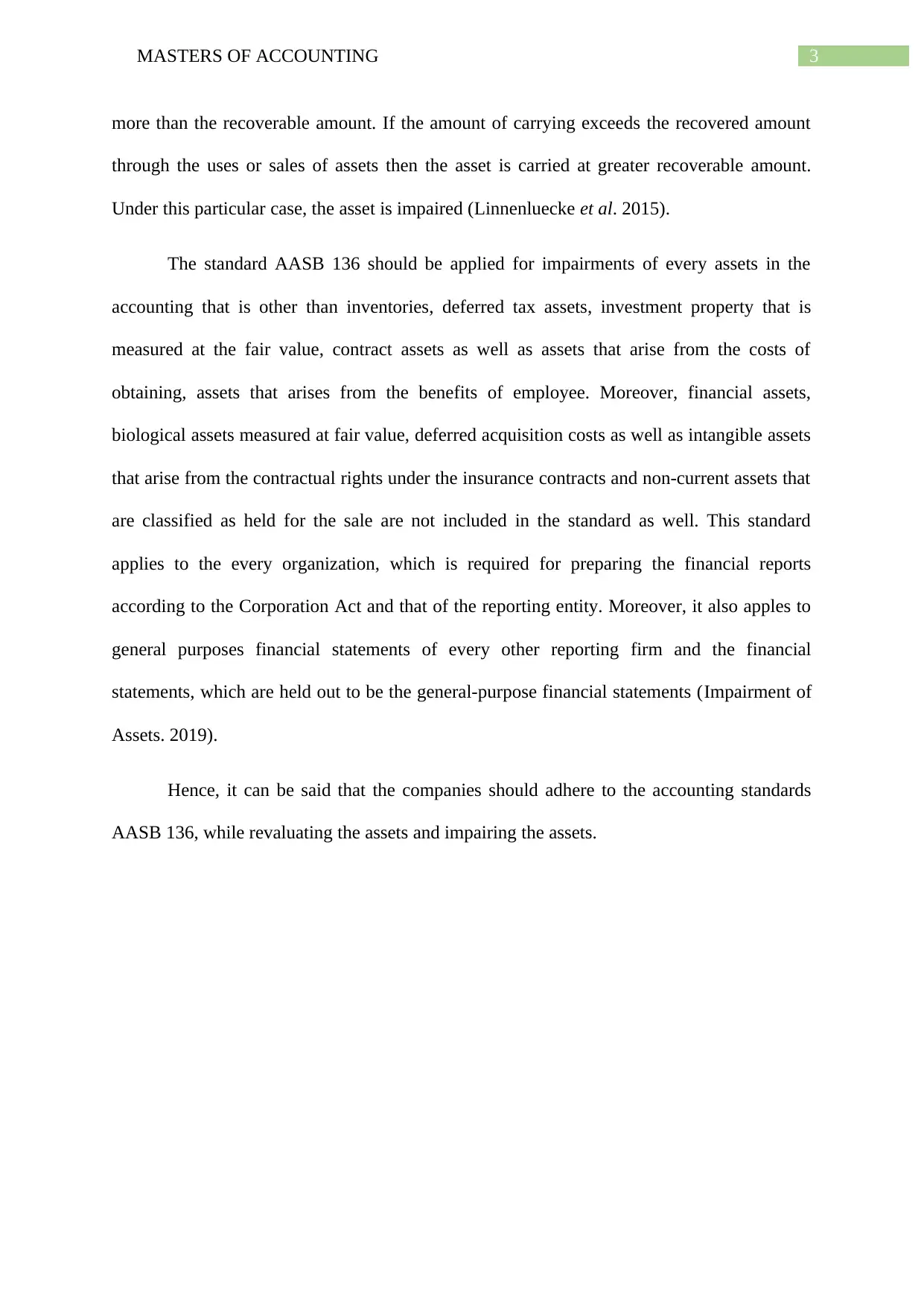
3MASTERS OF ACCOUNTING
more than the recoverable amount. If the amount of carrying exceeds the recovered amount
through the uses or sales of assets then the asset is carried at greater recoverable amount.
Under this particular case, the asset is impaired (Linnenluecke et al. 2015).
The standard AASB 136 should be applied for impairments of every assets in the
accounting that is other than inventories, deferred tax assets, investment property that is
measured at the fair value, contract assets as well as assets that arise from the costs of
obtaining, assets that arises from the benefits of employee. Moreover, financial assets,
biological assets measured at fair value, deferred acquisition costs as well as intangible assets
that arise from the contractual rights under the insurance contracts and non-current assets that
are classified as held for the sale are not included in the standard as well. This standard
applies to the every organization, which is required for preparing the financial reports
according to the Corporation Act and that of the reporting entity. Moreover, it also apples to
general purposes financial statements of every other reporting firm and the financial
statements, which are held out to be the general-purpose financial statements (Impairment of
Assets. 2019).
Hence, it can be said that the companies should adhere to the accounting standards
AASB 136, while revaluating the assets and impairing the assets.
more than the recoverable amount. If the amount of carrying exceeds the recovered amount
through the uses or sales of assets then the asset is carried at greater recoverable amount.
Under this particular case, the asset is impaired (Linnenluecke et al. 2015).
The standard AASB 136 should be applied for impairments of every assets in the
accounting that is other than inventories, deferred tax assets, investment property that is
measured at the fair value, contract assets as well as assets that arise from the costs of
obtaining, assets that arises from the benefits of employee. Moreover, financial assets,
biological assets measured at fair value, deferred acquisition costs as well as intangible assets
that arise from the contractual rights under the insurance contracts and non-current assets that
are classified as held for the sale are not included in the standard as well. This standard
applies to the every organization, which is required for preparing the financial reports
according to the Corporation Act and that of the reporting entity. Moreover, it also apples to
general purposes financial statements of every other reporting firm and the financial
statements, which are held out to be the general-purpose financial statements (Impairment of
Assets. 2019).
Hence, it can be said that the companies should adhere to the accounting standards
AASB 136, while revaluating the assets and impairing the assets.
Paraphrase This Document
Need a fresh take? Get an instant paraphrase of this document with our AI Paraphraser
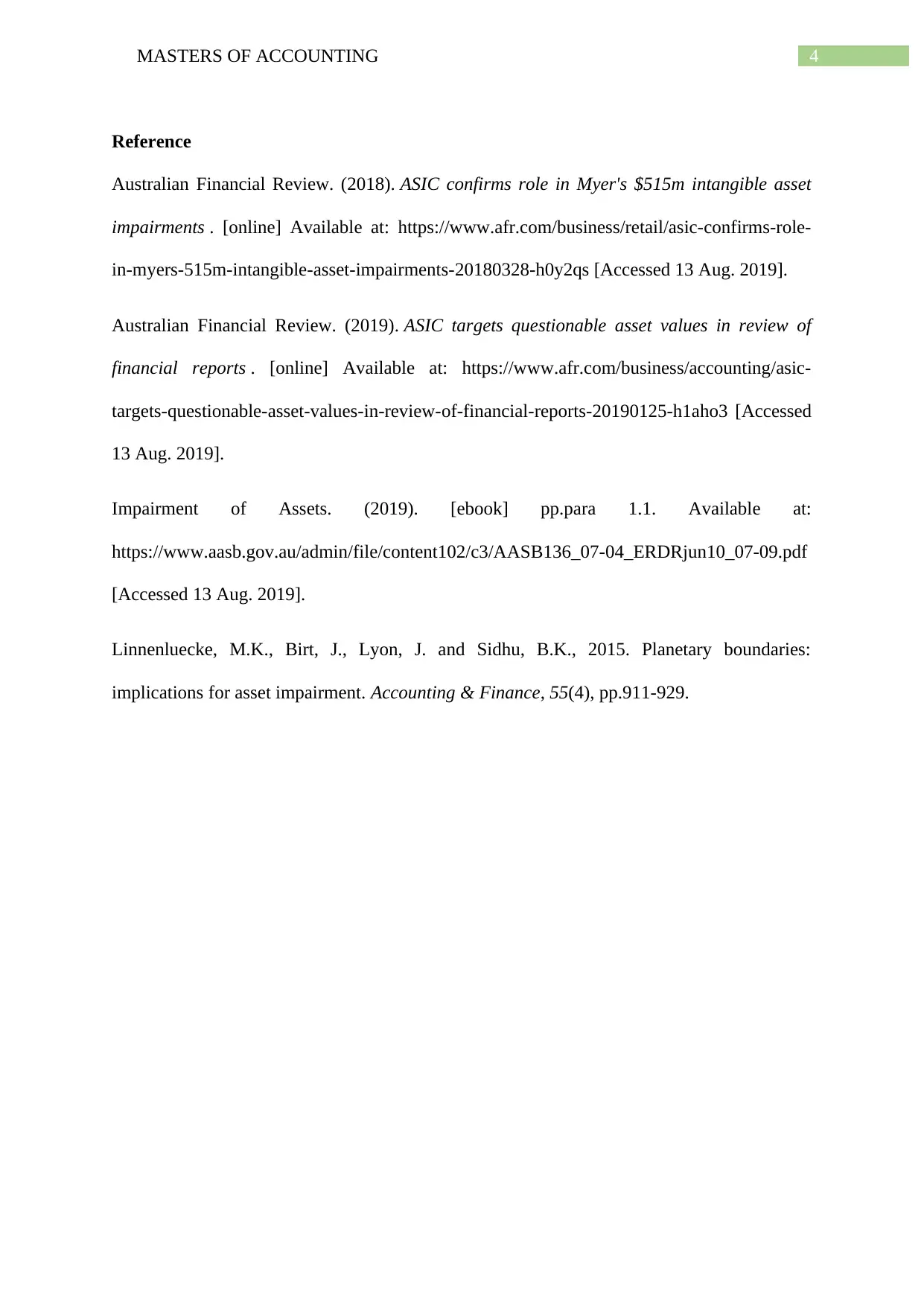
4MASTERS OF ACCOUNTING
Reference
Australian Financial Review. (2018). ASIC confirms role in Myer's $515m intangible asset
impairments . [online] Available at: https://www.afr.com/business/retail/asic-confirms-role-
in-myers-515m-intangible-asset-impairments-20180328-h0y2qs [Accessed 13 Aug. 2019].
Australian Financial Review. (2019). ASIC targets questionable asset values in review of
financial reports . [online] Available at: https://www.afr.com/business/accounting/asic-
targets-questionable-asset-values-in-review-of-financial-reports-20190125-h1aho3 [Accessed
13 Aug. 2019].
Impairment of Assets. (2019). [ebook] pp.para 1.1. Available at:
https://www.aasb.gov.au/admin/file/content102/c3/AASB136_07-04_ERDRjun10_07-09.pdf
[Accessed 13 Aug. 2019].
Linnenluecke, M.K., Birt, J., Lyon, J. and Sidhu, B.K., 2015. Planetary boundaries:
implications for asset impairment. Accounting & Finance, 55(4), pp.911-929.
Reference
Australian Financial Review. (2018). ASIC confirms role in Myer's $515m intangible asset
impairments . [online] Available at: https://www.afr.com/business/retail/asic-confirms-role-
in-myers-515m-intangible-asset-impairments-20180328-h0y2qs [Accessed 13 Aug. 2019].
Australian Financial Review. (2019). ASIC targets questionable asset values in review of
financial reports . [online] Available at: https://www.afr.com/business/accounting/asic-
targets-questionable-asset-values-in-review-of-financial-reports-20190125-h1aho3 [Accessed
13 Aug. 2019].
Impairment of Assets. (2019). [ebook] pp.para 1.1. Available at:
https://www.aasb.gov.au/admin/file/content102/c3/AASB136_07-04_ERDRjun10_07-09.pdf
[Accessed 13 Aug. 2019].
Linnenluecke, M.K., Birt, J., Lyon, J. and Sidhu, B.K., 2015. Planetary boundaries:
implications for asset impairment. Accounting & Finance, 55(4), pp.911-929.
1 out of 5
Related Documents
Your All-in-One AI-Powered Toolkit for Academic Success.
+13062052269
info@desklib.com
Available 24*7 on WhatsApp / Email
![[object Object]](/_next/static/media/star-bottom.7253800d.svg)
Unlock your academic potential
Copyright © 2020–2025 A2Z Services. All Rights Reserved. Developed and managed by ZUCOL.





